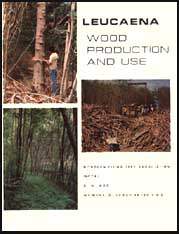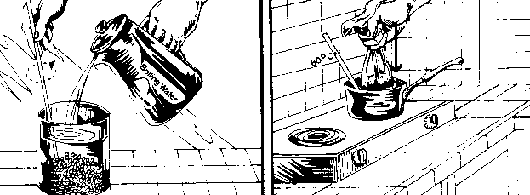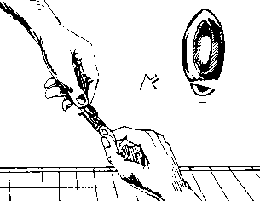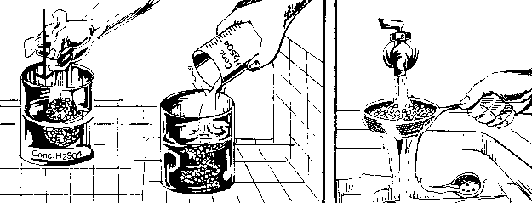The many leucaena varieties commonly sold can be divided into three main types:
- Giant: Tall and sparsely branched, good wood production (to 20m in height)
- Common: Short and bushy (3-8m in height)
- Peru: Multi-branched, leafy, medium height (5-12m)
Varieties that have proved superior in wood yields and for the production of roundwood, pulp, fuelwood, and afforestation are all of the giant type. Some outstanding and widely used giants are K8 (Mexico), K28 (Salvador), K29 (Honduras), K67 (Salvador), K132 (Mexico), and K636 (Mexico). These varieties have shown little apparent difference in yield, and composites can be considered for major plantations. Peru and common types should not be used for wood production.
Leucaena crosses readily with other species in the genus, and hybrids with I" diversifolia and L. pulverulenta show promise as high-yielding types in preliminary trials. Such hybrids may ultimately be used to expand the range of leucaena to colder and more acidic sites. It should be noted, however, that seed from such hybrids will probably not be marketed for several years.
A current list of seed dealers marketing these varieties can be obtained from the annual publication LEUCAENA RESEARCH REPORTS (NFTA, PO Box 680, Waimanalo, HI 96795, USA).
3-2 SCARIFICATION
Mature leucaena seeds have a hard seed coat that cannot absorb water. In nature, this usually results in seed germination over a long period of time. In order to promote uniform germination the seed coat must be cracked (scarified) to permit entry of water and thus hasten germination. There are 3 major methods of scarification:
- Hot-water scarification: Water is heated to a temperature of approximately 80° C. Seeds are added to the water in a ratio of about 1:3 (or 1 part seeds to 3 parts water), stirred for 3-4 minutes, then removed from the heat and washed with cool water. A cloth bag can be used to hold the seeds for immersion.
A common method of hot-water treatment is to use water brought to a vigorous boil, as if for coffee. This is poured over the seeds, allowing at least twice the volume of water to the volume of seeds. The mixture is stirred for 3-5 minutes, and the water poured off and replaced with cold. Care should be taken never to boil leucaena seeds.
Figure 3-1 Leucaena scarification methods:
HOT WATER SCARIFICATION - Seed is soaked for 5 minutes in 80°C water and rinsed with cold water. Alternatively, boiling water may be poured over seeds and allowed to cool to room temperature. Cooled water is then decanted. Seed is dried for storage.
BAND SCARIFICATION - A small fingernail clipper is a useful means to hand scarify Leucaena Clip the rounded end of the seed just enough to expose the endosperm. Use mostly limited to small samples of seed for experimental purposes.
CHEMICAL SCARIFICATION - Concentrated sulfuric acid is poured over seed just enough to wet them. Alternatively, seed may be dipped into cone. sulfuric acid in a nylon bag. Seed is stirred with a glass rod for 10-12 minutes, then exhaustively rinsed with running water to remove all acid. Dry seed for storage.
- Mechanical scarification: Individual seeds can be scarified with a razor, knife, fingernail clipper or scissors by cutting the rounded end of the seed, resulting in nearly perfect germination. Seed can also be scarified with sandpaper, carborundum or emery cloth by scratching the seed manually or by using a rotating drum designed for this purpose. Care should be taken to remove only enough of the seed coat to allow the seed to imbibe water. The seed coat need only be removed enough to barely be able to see the edge of the cotyledons, without actually cutting into the cotyledons themselves. Seeds which are prepared in this way should be used soon after scarification.
- Chemical scarification: Concentrated sulfuric acid weakens seed coats to permit the entry of water. It must be used with great care to avoid burns, and to avoid violent reaction with water. Seeds need only enough acid to be thoroughly moistened, and should be left about 13-15 minutes, stirring with a glass rod. Excess acid should be poured off and can be reused. The seeds should be poured into a plastic or nylon sieve and washed thoroughly in running water (3-5 minutes) prior to drying and use. Sodium hydroxide (lye) at a 20% concentration for one hour has also been reported as a useful agent for scarification. More experience is needed with this method.
Chemically scarified seed can be air dried and stored for years in a cool, dry place. Viability is reduced much more rapidly in warm, moist storage conditions.
Table 3-1 Comparison of scarification methods for leucaena.
|
80°C Water for 3-5 minutes |
H2SO4 for 12 minutes |
Hand Scarification |
No Treatment | |
|
Percent germination after 2 weeks |
90% |
95% |
95% |
10% |
|
Expense |
low |
medium |
high |
|
|
Storage capability (dried) |
6-12 mo |
6-12 mo |
6-12 mo |
1-5 yr |
|
Safety risk |
medium |
high |
low |
|
|
Germination time |
4-7 days |
4-7 days |
4-7 days |
4-60 days |
|
Ease of operation |
medium |
difficult |
simple |
3-3 SEED STORAGE
Dry leucaena seeds store well for many years. It appears they can be kept indefinitely under dry (30% relative humidity) and cool conditions. Scarification reduces the storage life of the seeds, if kept at ambient temperatures. Seeds that are scarified in hot water at 8P C for 2 minutes, followed by rapid drying, may be stored for as much as a year. However, it is generally best to sow seed immediately after scarification to avoid viability loss in storage.
Maintaining dry storage conditions is difficult in the humid tropics. Sealed polyethelene bags, cans, drums or dehumidified rooms are necessary. If seeds are dry, no damage may be expected from disease or insects. Seeds may need to be mixed with insecticide (e.g. Sevin) and fungicide (e.g., Captan) to prevent infestation during storage.
3-4 SEED PRODUCTION
Seed production of leucaena is relatively simple compared to many tree species. The trees flower in the first year, and seed yields are high by the second year. However, caution is needed to ensure purity of the seed from which the seed orchard is planted, and to ensure that harvested seeds are of high purity. Seeds can be collected in two major ways:
- From trees allowed to bear pods at the margins of plantations or hedgerows;
- From seed orchards planted and managed expressly as a seed source.
In the first approach, trees should not be identified for seeds until the second year, when their qualities are obvious. Since the purpose is to harvest seed of improved varieties, the roguing of off-types is extremely important. Rogues will normally be small shrubs, highly branched, highly flowering with small seed pods. Most certified seed will be highly pure to type and should not contain more than 2-5% rogues. Seed trees should be isolated from common types by a minimum of 100m.
Some of the important procedures in a seed production orchard are given below:
- Obtain seeds from a reputable source of certified origin
- Plant at a spacing of 1 x 2m
- Remove common leucaenas within 100m of the orchard
- Thin after 1-2 years to 2 x 3m or 3 x 3m spacing, removing any off-type plants carefully at this time
- Cut trees to a stump height of one meter to force side branching
Insect damage in the pods (weevils) can be eliminated by the application of a systemic insecticide like Cygon while pods are still green.
Seeds are collected when pods are completely brown, and should be removed before the pods begin to split. Tree pruners work well in seed collection, and the pods can be gathered in cloth bags. Alternatively, seed harvest can be made during pruning when branches are cut back vigorously to encourage further branching. Seed pods should be thoroughly sun dried until they shatter or are easily broken apart. Pods can be threshed by placing them in a bag, beating the bag and removing seeds from the bottom. Various sized threshers made for crops such as soybeans are available and work well for larger-scale operations.



